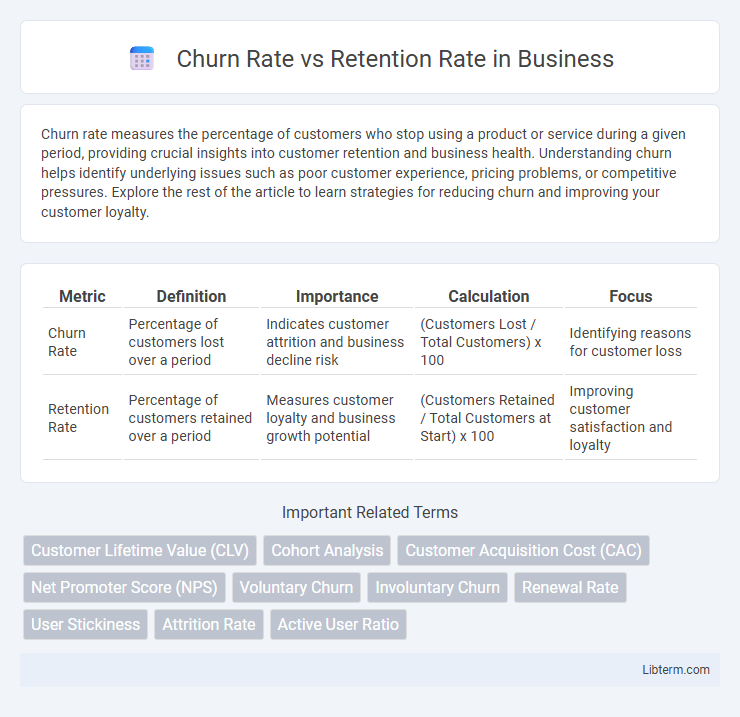Churn rate measures the percentage of customers who stop using a product or service during a given period, providing crucial insights into customer retention and business health. Understanding churn helps identify underlying issues such as poor customer experience, pricing problems, or competitive pressures. Explore the rest of the article to learn strategies for reducing churn and improving your customer loyalty.
Table of Comparison
| Metric | Definition | Importance | Calculation | Focus |
|---|---|---|---|---|
| Churn Rate | Percentage of customers lost over a period | Indicates customer attrition and business decline risk | (Customers Lost / Total Customers) x 100 | Identifying reasons for customer loss |
| Retention Rate | Percentage of customers retained over a period | Measures customer loyalty and business growth potential | (Customers Retained / Total Customers at Start) x 100 | Improving customer satisfaction and loyalty |
Introduction to Churn Rate and Retention Rate
Churn Rate measures the percentage of customers who stop using a product or service over a specific period, indicating customer loss and business health. Retention Rate reflects the proportion of customers who continue to engage with a brand, highlighting customer loyalty and satisfaction. Analyzing both metrics provides essential insights for optimizing customer relationship management and sustainable growth strategies.
Defining Churn Rate
Churn rate measures the percentage of customers who stop using a product or service during a specific time period, directly impacting overall business growth and revenue. It is calculated by dividing the number of lost customers by the total customers at the beginning of the period. Understanding churn rate helps businesses identify retention challenges and improve customer loyalty strategies.
Understanding Retention Rate
Retention rate measures the percentage of customers who continue using a product or service over a specific period, highlighting business stability and customer loyalty. It directly impacts revenue growth by reducing the need for acquiring new customers, which is often more costly than retaining existing ones. High retention rates correlate with improved customer lifetime value and stronger brand reputation, making it a critical metric for sustainable business success.
Key Differences Between Churn Rate and Retention Rate
Churn rate measures the percentage of customers who stop using a product or service during a specific period, while retention rate indicates the percentage of customers who continue their subscription or engagement over time. Churn rate focuses on customer loss, emphasizing challenges in maintaining the user base, whereas retention rate highlights customer loyalty and long-term satisfaction. Both metrics are crucial for assessing business health but serve opposite purposes in identifying growth opportunities and potential issues.
Importance of Churn Rate in Business Growth
Churn rate directly impacts a company's revenue by indicating the percentage of customers lost over a given period, making it a critical metric for business growth analysis. Lower churn rates correlate with higher customer retention, which reduces acquisition costs and enhances profitability by maintaining a stable customer base. Monitoring churn rate allows businesses to identify weaknesses in product offerings or customer service, enabling targeted strategies to improve client satisfaction and foster long-term growth.
The Role of Retention Rate in Customer Success
Retention rate plays a pivotal role in customer success by directly reflecting a company's ability to maintain long-term relationships with its clients. High retention rates indicate effective customer engagement, satisfaction, and loyalty, which lead to sustainable revenue growth and reduced acquisition costs. Monitoring retention rate provides actionable insights that help businesses optimize customer experience and proactively address potential churn.
Factors Influencing Churn and Retention Rates
Churn rate and retention rate are influenced by factors such as customer satisfaction, product quality, and service responsiveness, which directly impact consumer loyalty and defection. Pricing strategies, competitive offerings, and personalized customer experiences also play critical roles in determining the likelihood of customers staying or leaving a company. Understanding behavioral patterns and leveraging data analytics enables businesses to proactively reduce churn and enhance retention rates.
Calculating Churn Rate vs Retention Rate
Churn rate is calculated by dividing the number of customers lost during a period by the total number of customers at the start of that period, expressed as a percentage. Retention rate is determined by subtracting the number of lost customers from the total customers at the start, then dividing the remaining customers by the initial total and multiplying by 100 to get a percentage. Accurate calculation of both rates helps businesses assess customer loyalty and identify opportunities for growth.
Strategies to Reduce Churn and Improve Retention
Effective strategies to reduce churn rate include personalized customer engagement, proactive support, and timely feedback collection to identify pain points early. Enhancing user experience through product improvements and loyalty programs directly supports higher retention rates while fostering long-term customer relationships. Leveraging data analytics to segment customers enables targeted campaigns that address specific needs, significantly boosting retention and minimizing churn.
Monitoring and Optimizing Your Churn and Retention Metrics
Monitoring churn rate and retention rate provides critical insights into customer behavior and business health. Regular analysis of these metrics allows companies to identify patterns, address causes of customer attrition, and develop targeted strategies to improve customer loyalty. Implementing data-driven optimization techniques enhances customer engagement, reduces churn, and maximizes lifetime value effectively.
Churn Rate Infographic

 libterm.com
libterm.com